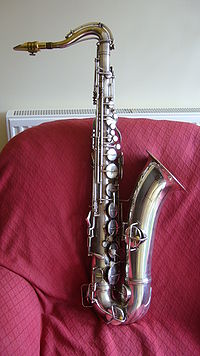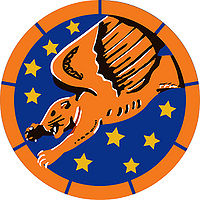| Line 16: | Line 16: | ||
His college career was cut short two years in, however, by Pearl Harbor in 1941 and America’s entry into WWII. Rather than wait for a draft, he decided to sign up for the war as a pilot, his flying experience making him a shoe-in for the Tuskegee Airmen as a fighter pilot (he eschewed entering the war as a musician, calling it the “coward’s way out”, but he always kept his saxophone with him, stowed under his seat “in case Franz tries to shoot my ass off” he said). | His college career was cut short two years in, however, by Pearl Harbor in 1941 and America’s entry into WWII. Rather than wait for a draft, he decided to sign up for the war as a pilot, his flying experience making him a shoe-in for the Tuskegee Airmen as a fighter pilot (he eschewed entering the war as a musician, calling it the “coward’s way out”, but he always kept his saxophone with him, stowed under his seat “in case Franz tries to shoot my ass off” he said). | ||
| − | [[File:600px-99th_Fighter_Squadron_patch.jpg]] | + | [[File:600px-99th_Fighter_Squadron_patch.jpg|200px|thumb|left|Patch of the 99th Fighter Squadron]] |
(Patch of the 99th Fighter Squadron, Parker's unit) (Source: http://www.af.mil/shared/media/) | (Patch of the 99th Fighter Squadron, Parker's unit) (Source: http://www.af.mil/shared/media/) | ||
Revision as of 11:57, 8 March 2012
John Parker
Master jazz saxophonist and starship pilot
Compared to any white child born in 1919, John Parker was poor, pure and simple. But compared to other African-American families of the time, Parker was indeed fortunate.
(A rare photo of John Parker during his time as a Tuskegee airman - far right) (Source: Archive.org)
His father had a steady manufacturing job in Kansas City, Kan., and his mother got part time work teaching music lessons, with no institution willing to hire on a “Negro” to a full-time job in the schools. Because of his mother, John grew up learning music at her knee, and quickly proved adept at the saxophone. He scraped together enough collecting scrap metal to purchase his own instrument, a beloved silver plated C.G. Conn tenor sax. From the day he bought it, it was never far from his side. When the depression hit, his father lost his manufacturing job, and the 10-year-old John kept the family afloat by playing on the street corners after school. He was skilled enough, he landed weekend gigs playing in local Kansas City venues and fell in love the burgeoning and popular jazz arising in the city.
(Parker's 1934 C.G. Conn brand 'New Wonder' Series II silver-plated tenor saxophone) (Source: Tom Oates, 2011)
These gigs meant that in addition to his family surviving, John could tuck a little away for college. In 1939, he attended Western University in Quindaro, Kan., near Kansas City - a historically black college and recognized nationally as one of the best college institutions in the first three decades of the 20th century United States. There he became a master on the saxophone and a competent singer. In his spare time, he took advantage of government programs designed to encourage African-Americans to get their private pilot’s license. His college career was cut short two years in, however, by Pearl Harbor in 1941 and America’s entry into WWII. Rather than wait for a draft, he decided to sign up for the war as a pilot, his flying experience making him a shoe-in for the Tuskegee Airmen as a fighter pilot (he eschewed entering the war as a musician, calling it the “coward’s way out”, but he always kept his saxophone with him, stowed under his seat “in case Franz tries to shoot my ass off” he said).
(Patch of the 99th Fighter Squadron, Parker's unit) (Source: http://www.af.mil/shared/media/)
He was assigned to the 332nd Fighter Group, seeing service in North Africa, Italy and finally as a bomber escort over Europe. Preferring the P-51 Mustang, John especially loved complaining about the sub-standard equipment the all-black unit was assigned.
 (John Parker's P-51 Mustang, "Rhoda") (Source: http://maxair2air.com/09AIR/P-51C-Homecoming/18.html)
(John Parker's P-51 Mustang, "Rhoda") (Source: http://maxair2air.com/09AIR/P-51C-Homecoming/18.html)
He seemed even more unlucky than most of his fellow pilots, usually experiencing a major failure in almost every mission, requiring him to turn back partway through most bombing runs. Regardless, John logged double-digit kills. During a final mission over Germany, John was unexpectedly pulled through the rift into Hiverspace, landing in a common area of Comorro station with only the clothes on his back, his twin Colt pistols and - thank Jesus - his saxophone, which came along for the ride just under his seat. His Mustang crashed in flames, and he was presumed killed in action. After he got over the initial shock and others got used to his presence on Comorro (he was one of the first through the rift three years ago), he adapted to his new circumstances by playing his saxophone on street corners and for gigs until he had enough money scraped together to become a starship pilot. He now hires himself out as a pilot or mercenary when he can and makes ends meet as a musician as best he can in-between jobs. DMC has hired him as a backup pilot and resident entertainer.


